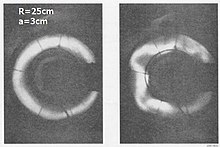
A kink instability (also known as a kink oscillation or kink mode) is a current-driven plasma instability characterized by transverse displacements of a plasma column's cross-section from its center of mass without any change in the characteristics of the plasma. It typically develops in a thin plasma column carrying a strong axial current which exceeds the Kruskal–Shafranov limit and is sometimes known as the Kruskal–Shafranov (kink) instability, named after Martin David Kruskal and Vitaly Shafranov.
The kink instability was first widely explored in fusion power machines with Z-pinch configurations in the 1950s. It is one of the common magnetohydrodynamic instability modes which can develop in a pinch plasma and is sometimes referred to as the mode. (The other is the mode known as the sausage instability.)
If a "kink" begins to develop in a column the magnetic forces on the inside of the kink become larger than those on the outside, which leads to growth of the perturbation. As it develops at fixed areas in the plasma, kinks belong to the class of "absolute plasma instabilities", as opposed to convective processes.
References
- Ryutov, D. D.; Furno, I.; Intrator, T. P.; Abbate, S.; Madziwa-Nussinov, T. (2006). "Phenomenological theory of the kink instability in a slender plasma column". Physics of Plasmas. 13 (3): 032105. Bibcode:2006PhPl...13c2105R. doi:10.1063/1.2180667. ISSN 1070-664X.
- DeHaas, Timothy; Gekelman, Walter; Van Compernolle, Bart (2015). "Experimental study of a linear/non-linear flux rope". Physics of Plasmas. 22 (8): 082118. Bibcode:2015PhPl...22h2118D. doi:10.1063/1.4928888. ISSN 1070-664X.
- Oz, E.; Myers, C. E.; Yamada, M.; Ji, H.; Kulsrud, R. M.; Xie, J. (2011). "Experimental verification of the Kruskal-Shafranov stability limit in line-tied partial-toroidal plasmas". Physics of Plasmas. 18 (10): 102107. Bibcode:2011PhPl...18j2107O. doi:10.1063/1.3647567. ISSN 1070-664X.
- Cap, Ferdinand F. (2013-09-11). Handbook on Plasma Instabilities. Academic Press. ISBN 9781483271057.
- Hasegawa, A. (2012-12-06). Plasma Instabilities and Nonlinear Effects. Springer Science & Business Media. ISBN 9783642659805.
- ^ Zohuri, Bahman (2017-02-23). Magnetic Confinement Fusion Driven Thermonuclear Energy. Springer. pp. 46–48. ISBN 9783319511771.
- Plasma Dictionary Archived 2006-09-29 at the Wayback Machine
This plasma physics–related article is a stub. You can help Misplaced Pages by expanding it. |
 mode. (The other is the
mode. (The other is the  mode known as the
mode known as the